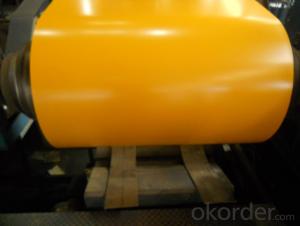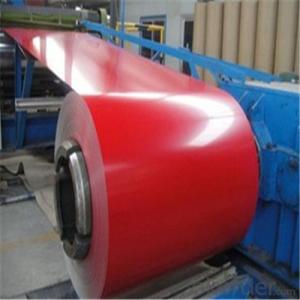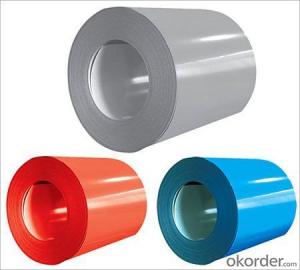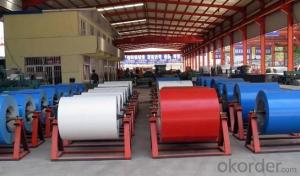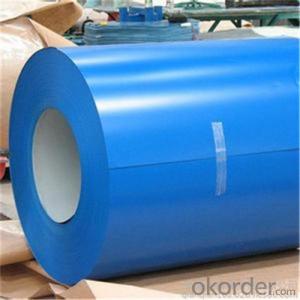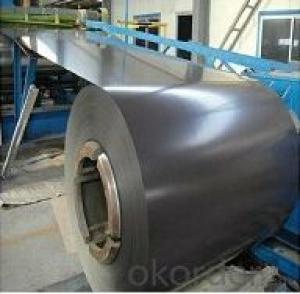Prepainted Galvanized Steel
- Loading Port:
- China Main Port
- Payment Terms:
- TT OR LC
- Min Order Qty:
- -
- Supply Capability:
- -
OKorder Service Pledge
OKorder Financial Service
You Might Also Like
Product Description:
Prepainted Galvanized Steel
With galvanized steel as base metal, after pretreatment (degrease and chemical treatment) and liquid dope with several layers of color, then after firing and cooling, finally the plate steel is called pre-painted galvanized steel. Pre-painted galvanized steel is good capable of decoration, molding, corrosion resistance. It generally displays superior workability, durability and weather resistance.
Brand Name: HBSTEEL
Specifications OfPrepainted Galvanized Steel
Thickness 0.20-1.2mm (BMT) Width 600-1250mm |
Zinc Coating 100-275g/m2 |
Color According to RAL color fan or as per request |
Internal Diameter 508mm or 610mm |
Coil Weight 3-6MT |
Quality Commercial and structural quality |
Paint Polyester paint for topside, epoxy for reverse |
Standard JIS G 3312, ASTM A755M, EN 10169 |
Base Steel Grade SGCC,SGCD,DX51D+Z,DX52D+Z;S200GD,S220GD,S280GD,S350GD,CS,FS,SS |
Chemical Composition Of Prepainted Galvanized Steel
C | Si | Mn | P |
0.04-0.06% | 0.01-0.03% | 0.18-0.22% | 0.014-0.016% |
Technical Data Of Prepainted Galvanized Steel
Yield Strength | (Mpa) 280-320 |
Tensile Strength | (Mpa) 340-390 |
Elongation | 20%-30% |
Reverse Impact | 9J |
T-bending | ≥2T |
Pencil Hardness | ≥2H |
Duration Of Salt Spray Test | 500 H |
Bending At 180 Degree | No crack, purling and fraction |
Applications OfPrepainted Galvanized Steel
It can be widely used in transportation, light industry, civil usage and farming. It is also the perfect building material in construction for making steel roofing,insulation panel, corrugate sheet, facade wall,shutters,T-bar and home appliance.
- Q: Brass as a rule I believe is betterhowever I do not plan to get into reloading any time soon I just want some cheap practice ammo so will steel case ammo hurt my gun (semi auto) any more than brass ammo and if so how much more?
- I think you answered the question correctly yourself. Yes. BRASS CASE IS BETTER. MUCH MUCH BETTER. Steel case is for the birds. Brass case feeds better in semi-autos as far as I can remember. High end guns all the way to cheapo's, the brass stuff is better. Ever notice how steel case cartridges almost always seem to have visible bulges in the cases right at the butt ends of the bullets? ? ? Not quite so with brass ammo. Cheap shots or expensive shots I prefer ammo in brass.
- Q: What are the common methods of painting steel coils?
- There are several common methods used for painting steel coils, depending on the specific requirements and desired outcomes. Here are some of the most commonly employed methods: 1. Coil coating: This is the most common method used for painting steel coils. It involves applying a layer of paint on the coil's surface before it is shaped into its final form. The coil is first cleaned and pre-treated with chemicals to ensure proper adhesion of the paint. Then, the paint is applied using various techniques such as roll coating, spray coating, or dip coating. The coil is then cured in an oven to ensure proper drying and adhesion of the paint. 2. Electrostatic painting: This method involves using an electrostatic charge to apply the paint onto the steel coil. The coil is first cleaned and pre-treated, and then an electrostatic charge is applied to the paint particles. The charged particles are attracted to the grounded coil, resulting in an even and efficient paint application. This method is often used for high-performance coatings as it provides excellent coverage and adhesion. 3. Powder coating: Powder coating is a popular method for painting steel coils, especially for applications that require a durable and long-lasting finish. In this method, a dry powder paint is applied to the coil's surface electrostatically. The powder adheres to the coil due to the electrostatic charge, and then the coil is heated in an oven to melt and cure the powder, forming a smooth and protective coating. 4. Spray painting: Spray painting is commonly used for smaller steel coils or touch-up applications. It involves using a spray gun to apply the paint onto the coil's surface. The coil is cleaned and pre-treated, and then the paint is sprayed in a controlled and even manner. This method allows for precise control and customization of the paint application. Overall, the choice of painting method depends on factors such as the desired finish, durability requirements, cost considerations, and the specific application of the steel coil. Each method has its own advantages and limitations, and it is important to select the most suitable method based on the specific needs and constraints of the project.
- Q: I work with stainless steel a lot and I know it's rust resistant but it's definitly not STAIN resistant. You might be able to remove some stains easier from it than you can from some other surfaces but when it does stain, its hard as heck to clean it. It takes forever to scrub stains off my stainless steel pans so maybe it should just be called rustless steel?
- It is called stainless because it is much more highly resistant to rust and corrosion. It is stainless in camparison to other steels, such as carbon steel.
- Q: My neighbor who has an older model mustang installed a steel clutch in it and has blown 4 transmissions as a result.Can any mechanic explain why a steel clutch would kill transmissions? What other modifications would the car need in order to prevent this?
- figger he would learn after a tranny or two...no reasion for any clutch to wreck a tranny.must b bad instalation..or he cant drive
- Q: If you were selecting a tool steel for an extreme impact load application, which one would you pick? why?thanks
- It all depends what the application actually is. For hammers I would select a hammer grade B1 steel. For impact loading where an edge is needed I would be going for O1 or similar (oil quenching steels tend to be a little tougher than air hardening). For mining tools a very high manganese steel (Hadfields steel) - this is not a true tool steel. The best place to start is by looking at the ranking of the properties which you want - hardness v toughness v strength - and then use this to put the steels in rank order. Price and availablity then sort the problem out for you (in the real world).
- Q: which is the most tough and durable steel type ??
- C'mon. Really? That's your question? How about some actual details like the application, is it going to be formed into a shape, do you need to weld it, what type of environment like corrosion and temperature is it going to be subject to? There are roughly 2,000 grades of steel and a couple hundred grades of stainless steel. Steels can be soft or they can be exceptionally hard. We need more info please.
- Q: What are the different methods of storing steel coils?
- There are several methods of storing steel coils, depending on the specific requirements and constraints of the storage facility. Some of the commonly used methods include: 1. Stack storage: This method involves stacking the steel coils on top of each other in a stable manner. It is a cost-effective method, as it maximizes the use of vertical space. However, it requires careful stacking to ensure stability and prevent damage to the coils. 2. Block stacking: In this method, steel coils are arranged in blocks, with each coil placed directly on top of another. The blocks are then stacked to maximize the use of space. This method provides stability and allows for easy access to individual coils. However, it may require the use of additional equipment such as coil cradles or coil saddles to prevent damage. 3. Coil cradles: Coil cradles are specialized racks or frames that are designed to hold steel coils horizontally. They provide support and prevent the coils from rolling or shifting. This method is particularly suitable for smaller coils or when quick access to individual coils is required. 4. Coil saddles: Coil saddles are U-shaped frames that are specifically designed to hold and support steel coils vertically. They are often used in conjunction with block stacking or stack storage methods. Coil saddles provide stability and prevent the coils from rolling or collapsing. 5. Coil racks: Coil racks are steel structures that are designed to hold multiple coils in an organized manner. They may have several levels or tiers, allowing for efficient use of space. Coil racks are typically used for larger coils and can be customized to accommodate specific coil dimensions. 6. Automated storage systems: In large-scale storage facilities, automated systems such as coil cranes or coil carousels may be employed. These systems use mechanical devices to transport and store steel coils, allowing for efficient and fast retrieval when needed. They are particularly useful in high-volume operations where frequent coil handling is required. It is essential to consider factors such as coil size, weight, accessibility, and environmental conditions when determining the most suitable method of storing steel coils. Additionally, proper handling, labeling, and regular inspections are crucial to ensure the integrity and longevity of the stored coils.
- Q: Im looking at some knives and am wandering if they use good steel one is this case knife and its 54 dollars Do they use good steel or not Iv never had a good experience with Case but am wandering if they use good steel now? if you all have any other recommendations let me hear them I got my Selection from here so any others wont hurt. so basic break down does case use good steel know?
- Vintage Case Knives
- Q: can u use stainless steel to make a coin? why or why not? answers based on facts plz.
- Stainless steel has been used by some countries to make coins, but it's not an ideal metal. When a coin is struck, a die comes down and strikes the blank with many tons of force (the blank is also sitting on top of another die--one has the image on the obverse (front) of the coin, while the other die has the image of the reverse of the coin). When the die strikes the blank, the force causes the metal in the blank to flow into the recesses of the die. The problem with stainless steel is that it doesn't want to flow into the die. To get an image, either the relief (how high the raised portion of the design will be) has to be very low, and the coin has to have a simple design, or they have to greatly increase the pressure of the strike. This slows the coining press down, and greatly shortens the life of the dies.
- Q: When maintaining a japanese knife: Is a honing steel still necessary if I have a fine 3000/8000 grit whetstone?which do you prefer?
- A steel is to clean off an edge and remove any bends on the bevel, it is not directly for sharpening as it removes no material from the knife (or should not). A whetstone, however fine, does remove material. A steel to maintain an edge, a stone to restore an edge. They are different items for different purposes.
Send your message to us
Prepainted Galvanized Steel
- Loading Port:
- China Main Port
- Payment Terms:
- TT OR LC
- Min Order Qty:
- -
- Supply Capability:
- -
OKorder Service Pledge
OKorder Financial Service
Similar products
Hot products
Hot Searches
Related keywords
